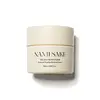What's inside
What's inside
 Key Ingredients
Key Ingredients

 Benefits
Benefits

 Concerns
Concerns

 Ingredients Side-by-side
Ingredients Side-by-side

Water
Skin ConditioningHelianthus Annuus Seed Oil
EmollientCaprylic Acid
CleansingC10-18 Triglycerides
EmollientGlycerin
HumectantArachidyl Alcohol
EmollientBehenyl Alcohol
EmollientArachidyl Glucoside
EmulsifyingRosa Canina Fruit Extract
AstringentSodium Hyaluronate Crosspolymer
HumectantMandelic Acid
AntimicrobialGluconolactone
Skin ConditioningLactobionic Acid
BufferingBuddleja Davidii Leaf Cell Culture Extract
Skin ConditioningXanthan Gum
EmulsifyingCaprylhydroxamic Acid
Glyceryl Caprylate
EmollientSodium Acrylates Copolymer
Lecithin
EmollientCeramide NP
Skin ConditioningResveratrol
AntioxidantTetrahydrodiferuloylmethane
AntioxidantTetrahydrodemethoxydiferuloylmethane
AntioxidantTetrahydrobisdemethoxydiferuloylmethane
AntioxidantSodium Ascorbyl Phosphate
AntioxidantWater, Helianthus Annuus Seed Oil, Caprylic Acid, C10-18 Triglycerides, Glycerin, Arachidyl Alcohol, Behenyl Alcohol, Arachidyl Glucoside, Rosa Canina Fruit Extract, Sodium Hyaluronate Crosspolymer, Mandelic Acid, Gluconolactone, Lactobionic Acid, Buddleja Davidii Leaf Cell Culture Extract, Xanthan Gum, Caprylhydroxamic Acid, Glyceryl Caprylate, Sodium Acrylates Copolymer, Lecithin, Ceramide NP, Resveratrol, Tetrahydrodiferuloylmethane, Tetrahydrodemethoxydiferuloylmethane, Tetrahydrobisdemethoxydiferuloylmethane, Sodium Ascorbyl Phosphate
Water
Skin ConditioningC13-15 Alkane
SolventButylene Glycol
HumectantC15-19 Alkane
SolventCaprylic/Capric Triglyceride
MaskingGlycerin
HumectantTrioctyldodecyl Citrate
EmollientPolyglyceryl-3 Polyricinoleate
EmulsifyingPolyglyceryl-4 Diisostearate/Polyhydroxystearate/Sebacate
EmulsifyingIsosorbide Dicaprylate
Skin ConditioningSynthetic Beeswax
Emulsion StabilisingDisteardimonium Hectorite
StabilisingPanthenol
Skin ConditioningTocopherol
AntioxidantTocopheryl Acetate
AntioxidantPalmitoyl Tripeptide-8
Skin ConditioningPalmitoyl Tetrapeptide-10
Skin ConditioningZingiber Officinale Root Extract
MaskingAstrocaryum Murumuru Seed Butter
EmollientPolyglutamic Acid
Skin ConditioningSodium Hyaluronate
HumectantHydrolyzed Glycosaminoglycans
HumectantBisabolol
MaskingTremella Fuciformis Polysaccharide
Emulsion StabilisingCeramide NP
Skin ConditioningHyaluronic Acid
HumectantHydrolyzed Hyaluronic Acid
HumectantCaprylhydroxamic Acid
Dextran
Trisodium Ethylenediamine Disuccinate
Phenoxyethanol
PreservativeEthylhexylglycerin
Skin ConditioningCitric Acid
BufferingSodium Chloride
MaskingBenzyl Alcohol
PerfumingWater, C13-15 Alkane, Butylene Glycol, C15-19 Alkane, Caprylic/Capric Triglyceride, Glycerin, Trioctyldodecyl Citrate, Polyglyceryl-3 Polyricinoleate, Polyglyceryl-4 Diisostearate/Polyhydroxystearate/Sebacate, Isosorbide Dicaprylate, Synthetic Beeswax, Disteardimonium Hectorite, Panthenol, Tocopherol, Tocopheryl Acetate, Palmitoyl Tripeptide-8, Palmitoyl Tetrapeptide-10, Zingiber Officinale Root Extract, Astrocaryum Murumuru Seed Butter, Polyglutamic Acid, Sodium Hyaluronate, Hydrolyzed Glycosaminoglycans, Bisabolol, Tremella Fuciformis Polysaccharide, Ceramide NP, Hyaluronic Acid, Hydrolyzed Hyaluronic Acid, Caprylhydroxamic Acid, Dextran, Trisodium Ethylenediamine Disuccinate, Phenoxyethanol, Ethylhexylglycerin, Citric Acid, Sodium Chloride, Benzyl Alcohol
 Reviews
Reviews

Ingredients Explained
These ingredients are found in both products.
Ingredients higher up in an ingredient list are typically present in a larger amount.
Caprylhydroxamic Acid is a chelating agent.
Chelating agents help prevent metal ions from binding to other ingredients. This helps prevent unwanted reactions and effects from using the product.
Caprylhydroxamic Acid is often used with natural antimicrobial products as an alternative to preservatives.
Learn more about Caprylhydroxamic AcidCeramide NP is a type of ceramide and formally known as ceramide 3.
Ceramides are intercellular lipids naturally found in our skin that bonds dead skin cells together to create a barrier. They are known for their ability to hold water and thus are a great ingredient for dry skin.
Ceramides are an important building block for our skin barrier. A stronger barrier helps the skin look more firm and hydrated. By bolstering the skin ceramides act as a barrier against irritating ingredients. This can help with inflammation as well.
If you would like to eat ceramides, sweet potatoes contain a small amount.
Read more about other common types of ceramides here:
Ceramide AP
Ceramide EOP
Glycerin is already naturally found in your skin. It helps moisturize and protect your skin.
A study from 2016 found glycerin to be more effective as a humectant than AHAs and hyaluronic acid.
As a humectant, it helps the skin stay hydrated by pulling moisture to your skin. The low molecular weight of glycerin allows it to pull moisture into the deeper layers of your skin.
Hydrated skin improves your skin barrier; Your skin barrier helps protect against irritants and bacteria.
Glycerin has also been found to have antimicrobial and antiviral properties. Due to these properties, glycerin is often used in wound and burn treatments.
In cosmetics, glycerin is usually derived from plants such as soybean or palm. However, it can also be sourced from animals, such as tallow or animal fat.
This ingredient is organic, colorless, odorless, and non-toxic.
Glycerin is the name for this ingredient in American English. British English uses Glycerol/Glycerine.
Learn more about GlycerinWater. It's the most common cosmetic ingredient of all. You'll usually see it at the top of ingredient lists, meaning that it makes up the largest part of the product.
So why is it so popular? Water most often acts as a solvent - this means that it helps dissolve other ingredients into the formulation.
You'll also recognize water as that liquid we all need to stay alive. If you see this, drink a glass of water. Stay hydrated!
Learn more about Water